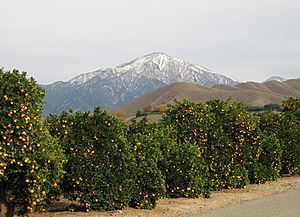Crafton, California facts for kids
Quick facts for kids
Crafton, California
|
|
|---|---|

Orange trees at the intersection of Crafton and Citrus Avenues.
San Gorgonio Mountain in the distance |
|
| Country | United States |
| State | California |
| County | San Bernardino |
| Elevation | 1,755 ft (535 m) |
| Time zone | UTC-8 (PST) |
| • Summer (DST) | UTC-7 (PDT) |
| ZIP codes |
92374
|
| Area code(s) | 909 |
| GNIS feature ID | 252875 |
Crafton is a small community in San Bernardino County, California, United States. It is not a city, but an unincorporated community, meaning it is not governed by its own local city government. Crafton is located east of Redlands, south of Mentone, and west of Yucaipa, California. It is well-known for its historical roots and beautiful citrus groves.
Contents
History of Crafton
Crafton was one of the very first communities to be settled in the San Bernardino Valley area. Around 1857, Lewis Cram and his brothers moved here to use the water flow from the community aqueduct, called the zanja (which is Spanish for ditch), for their milling business.
Early Settlers and Farming
Soon, other settlers began to arrive in the area. They started planting various crops like barley, wheat, grapes, apples, and peaches. In 1858, George H. Crafts, Sr. bought land for his brother Myron, who arrived in 1861. George had already started growing many crops.
A big change happened in 1870 when Myron H. Crafts planted a small field of navel oranges. His orange crop was very successful, which inspired others in the area to plant more oranges. The Crafts ranch became a popular place for people to visit and relax. One person who felt better after visiting called it "Crafton," and the area has been known by that name ever since.
Water Rights and Disputes
As Crafton grew, it started to produce as much food as Old San Bernardino. Myron H. Crafts, who was known for being smart and energetic, began to use a lot of water from the zanja, which brought water from Mill Creek. This led to disagreements over water rights.
In 1864, a court case decided that Myron Crafts could only use water from the zanja for a few hours each day. Later, in 1870, another court case further defined his right to four hours of water per day. These water disputes were common as the community grew and more farms needed water for their crops.
Community Growth and Development
In 1873, the first Protestant church service in the San Bernardino Valley was held at the Crafts family home. This showed the community was growing beyond just farming.
By 1882, Myron H. Crafts had bought a lot of land, about 1,800 acres (7.3 square kilometers). He then started the Crafton Land and Water Company and built the Crafton Reservoir to store water for the community.
- The Crafton School District was created in 1882.
- A new schoolhouse was built in 1888.
- A post office opened in Crafton in 1885, with Myron H. Crafts as the first postmaster.
- In 1886, other residents formed the Crafton Water Company. They bought the reservoir from Crafts and made it bigger.
Native American Community
During the 1870s and 1880s, many Cahuilla Native Americans lived in Crafton. They often worked in agriculture, helping with crops and taking care of sheep and other animals for the white settlers. Myron Crafts even built a store in the early 1880s specifically for trading with the Native Americans. The first floor was a general store, and the second floor was used for Sunday School classes.
Geography of Crafton
Crafton is located on a gently sloping plain in the San Bernardino basin. The land gradually rises as you go towards the southeast. The area is quite dry, so it needs irrigation, or watering systems, to keep the famous navel orange groves healthy. Luckily, there is plenty of mountain water available from the Zanja Aqueduct.
Crafton Hills
South and east of Crafton are the Crafton Hills. These are low, rolling hills formed by several active faults (cracks in the Earth's crust) that move up and down. This area is known as the Crafton Hills fault zone. The highest point in these hills is Zanja Peak, which reaches about 3,297 feet (1,005 meters) high. This is about 1,600 feet (488 meters) higher than Crafton itself.
The Crafton Hills are home to Crafton Hills College, a local college. The area also has recreational trails for hiking and the Crafton Reservoir, which provides water to Crafton and the nearby city of Redlands.
Crafton holds a special record: on November 12, 1906, it recorded the highest temperature ever in the United States for the month of November, reaching 105.1 °F (40.6 °C).
Community Life
The nearby city of Redlands sees Crafton as part of its general area of influence. Crafton itself does not have its own specific community plan. However, residents have worked hard to keep a rural, country feel. About half of the homes in Crafton are hidden among citrus groves.
One goal for Crafton has been to keep large lots for homes, often around 5 acres (2 hectares) per house. This helps maintain the rural atmosphere and prevents the area from being taken over by Redlands.
Water and Farming Concerns
Because Crafton's sloping land helps collect water for Redlands, the city is always interested in Crafton's water situation. Most homes in Crafton use city water but rely on septic tank systems for wastewater instead of city sewer services.
Crafton's historic citrus groves are not very expensive to maintain, which means it might be one of the last farming communities in the San Bernardino Valley. However, there are concerns about keeping the necessary farming tools and systems in place. Also, increasing traffic through the area could make farming more difficult.



